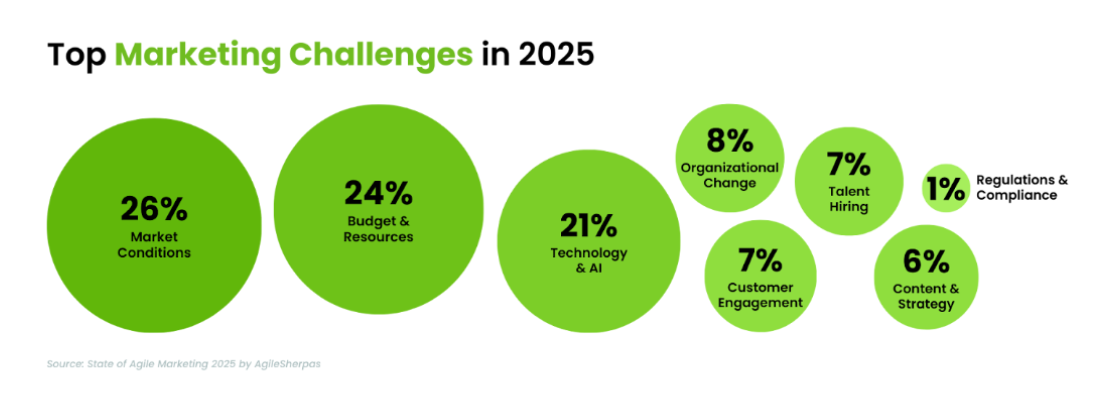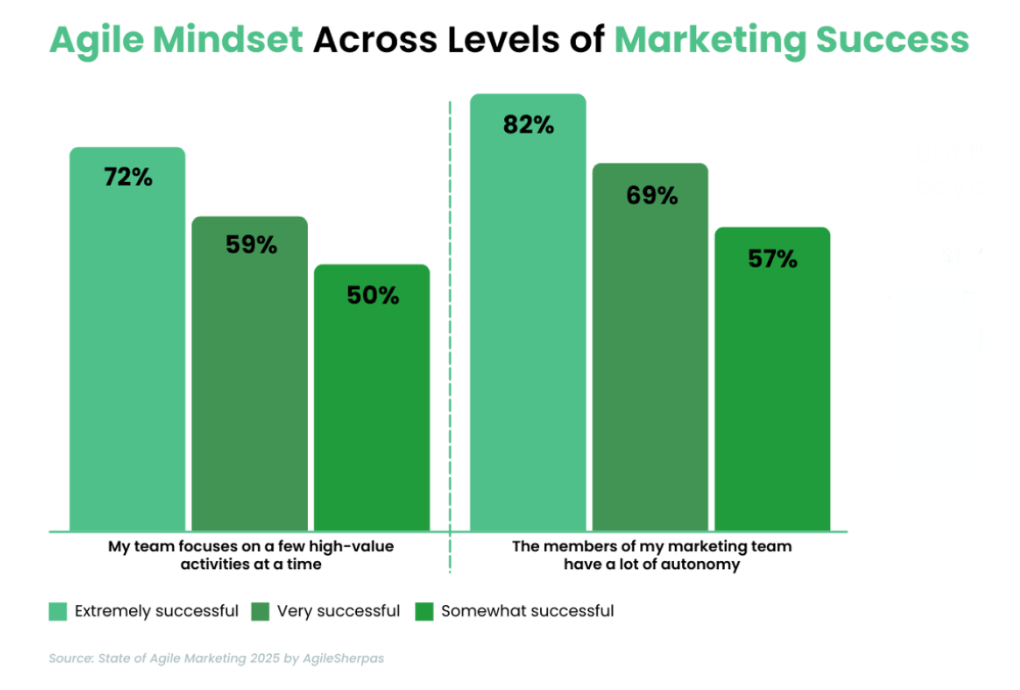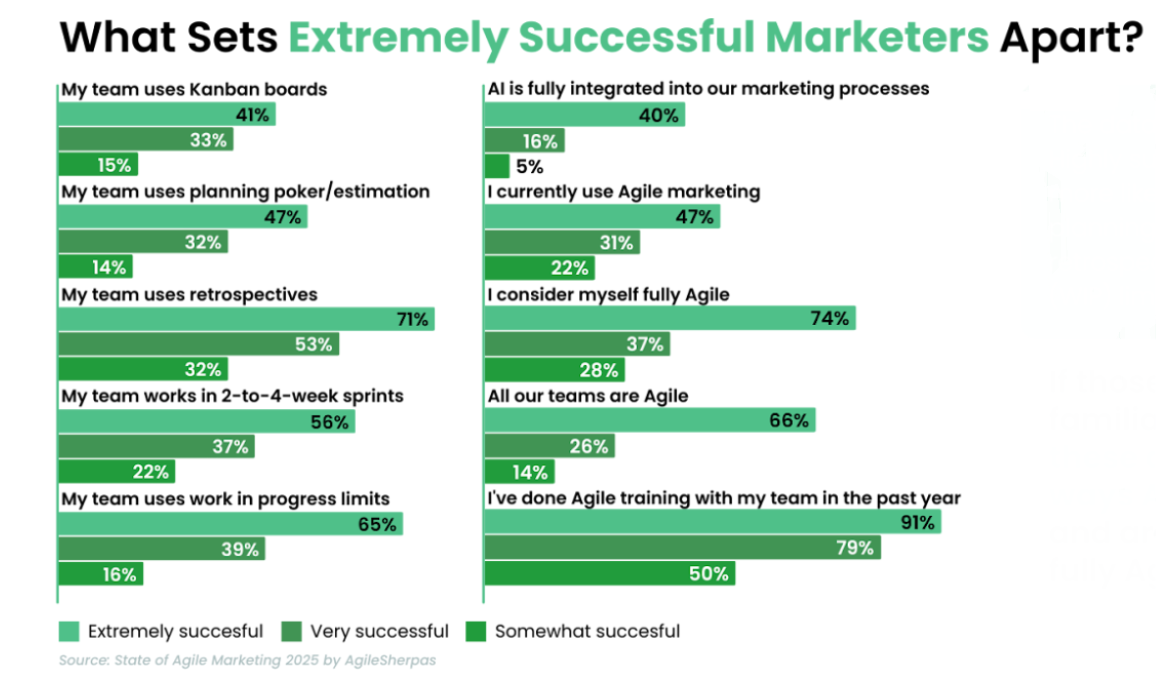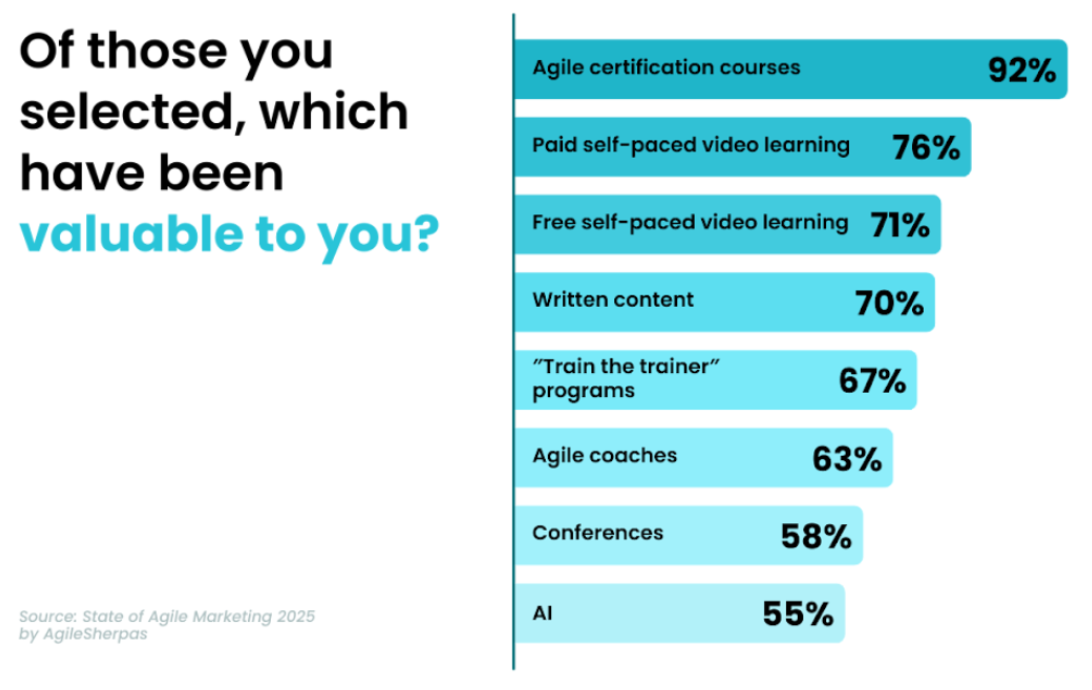Achieving sustainable marketing agility requires understanding the fundamentals behind the Agile mindset. From there, you can select the tools, framework, and education/training approach that best fits your needs. Once you’ve started to implement Agile marketing, consistency, regular training, and data-driven continuous improvement are key for sustaining and building on the benefits you’ve already unlocked.
In its 8 years, our annual State of Agile Marketing Report has consistently found that agility enables marketers to be more efficient, productive, adaptable, and more. But the 2025 edition brought a new reason why enabling and sustaining marketing agility is critical for success: AI.
It found that fully Agile teams were more than 3x more likely to have fully implemented AI. From there, 2/3rds found that AI significantly enhanced their agility. It’s a symbiotic relationship that’s enabling Agile marketers to really outperform their competitors.
But as we move from “should we be Agile?” to “how can we be Agile?” the answers become more complex. It’s no longer a matter of finding evidence that Agile works in marketing; we have to craft rollout blueprints and scaling models and change management plans.
Fortunately, that report and our own experience here at AgileSherpas have taught us how to effectively enable and sustain Agile marketing at all kinds of organizations.
These are the five most critical tools to have in your own transformation toolbox if you want Agile to be a permanent fixture in your marketing organization.
What Is Marketing Agility?
Beginning with a solid understanding of marketing agility is more vital than you think. In fact, misunderstandings around marketing agility are an all-too-common problem that tends to create significant issues when trying to implement Agile ways of working. So what do you really need to understand here?
First, Agile marketing is more than just a set of practices. This is enormously important to appreciate because teams often get frustrated when they begin doing things like holding standups and using visualization tools before wondering why they aren’t getting the full Agile benefits they hoped for.
In fact, our State of Agile Marketing Report consistently finds that many of the most successful Agile marketing teams don’t use many common Agile practices like WIP limits or working in sprints. So if Agile isn’t just your practices and processes, what is it?
At the core of true Agility (and Agile success) is mindset.
The reason is that there are a nearly infinite number of ways to be Agile. A huge part of implementing agility in marketing is figuring out the best approach for your needs. Because that process involves making many decisions and adaptations, you need a foundational mindset and set of principles to guide you. Otherwise, teams often adapt Agile practices in ways that actually undermine their core benefits.
That’s why an Agile mindset is an essential prerequisite for enabling and sustaining marketing agility. We’ll discuss how to cultivate that mindset more below.
Why Do You Need Marketing Agility Today?
This year’s State of Agile Marketing Report surveyed hundreds of marketers around the world to understand why marketing agility is more vital now than ever before.
Agile Marketing Is Ideally Suited for Today’s Challenges
The first reason relates to the main challenges marketers face today. When we asked them about this, market conditions, budget & resources, and technology & AI stood out. The reason is hardly surprising to anyone in the industry. The world is changing faster than ever and marketers are consistently being asked to do more with less, particularly with AI.

In this environment, Agile marketers stand out because they are better able to quickly adapt to change, get the most out of limited resources, and are far more likely to implement AI. Let’s break down each individually.
Adapting to Change
When we asked fully Agile teams about how effective they were, we found that the majority were able to:
- Clearly prioritize work
- Align between marketing and other departments
- Deliver projects/campaigns faster
In addition, fully Agile marketing teams generally had more autonomy and focused on a smaller number of high-value activities at once. This flexibility enables them to change when circumstances do. That might be when early results from a campaign show poor performance or when a major world event totally upends the entire market (when does that ever happen, right?)
What’s important here is that Agile was designed from the ground up with this kind of adaptability in mind.
Optimizing Limited Resources
Another key benefit of Agile marketing that’s deeply connected with adaptability is optimization. Agile mindsets are designed to promote a culture of continuous improvement. That means constantly looking for ways to improve processes, hone messaging, try new tools, and more.
This culture is ideally suited to doing more with less because Agile marketing is built around doing the right work at the right time. Or, put another way, Agile marketing emphasizes NOT doing work that isn’t actually going to add value, enabling marketers to focus on what really matters.
Implementing AI
This adaptability, experimentation, and optimization are all ideally suited to implementing AI. Today, new AI tools are being developed and released literally every day. For marketers, this can feel overwhelming, especially when senior leaders are telling them they need to effectively integrate these tools into their processes yesterday.
Agile provides a framework for testing AI tools in creative ways in order to actually enable marketers to do their job better. Agile marketers have the mindset, autonomy, and culture to do this, making it hardly surprising they’re so much more likely to embrace AI compared to their less Agile counterparts.
Key Components of Marketing Agility
While marketing Agility can look very different from team to team, there are some core components that define it.
Transparency
Agile is all about breaking down silos that divide teams and functions within organizations. When information flows freely, people are able to make better and more informed decisions. Otherwise, barriers slow people down, create waste, and even contribute to a more complacent culture.
This also extends to how information is shared within teams. Agile teams typically use visualization boards like those used in Kanban. These boards enable everyone to see the status of work items, leave comments, share feedback, etc. in a single location. This makes it far easier for teams to function because it largely eliminates the need to waste time asking for status updates. It’s also particularly useful for remote or distributed teams where such questions can easily delay work by a full day.
Alignment
Another common byproduct of silos is alignment challenges. Marketing may be optimizing its own processes, but that can lead to huge headaches for compliance. Multiply those issues by all the functions in the organization and you quickly have big headaches.
Agile marketing is built around stakeholder engagement and value delivery. Those stakeholders don’t just include customers but other functions like compliance. The culture and processes of Agile teams are designed to get feedback from relevant stakeholders and ensure planning and decision making takes them into consideration. It’s no wonder 58% of fully Agile teams report better alignment between marketing and other departments in our latest State of Agile Marketing Report.
Cross-Functionality
Ideally, Agile marketing teams will be cross-functional. This means the team will contain all the people and skills needed to accomplish its work. This makes it far easier for teams to experiment, plan, and function. The reason is in part because being “half Agile” just doesn't work. In order to work properly everyone on an Agile team needs to be fully on that team.
Occasionally, this creates the need for things like shared services teams which bring together one type of work, like designers, to share their skills across other teams. But ideally, Agile marketing teams are fully cross-functional and able to execute on their own.
Autonomy
This year’s State of Agile Marketing Report found that one of the key elements for Agile success in areas like AI implementation was autonomy. In fact, 82% of extremely successful marketers reported having a lot of autonomy compared to just 57% of those who were just somewhat successful.

In the Agile world, we often frame this autonomy around the what and how. Senior leaders work with marketers to develop strategic goals, the “what” that marketing will try to achieve. However, after those goals are determined, marketers have the autonomy to figure out the best “how” to achieve those goals.
Likewise with things like AI, senior leaders can encourage marketing to implement it, but marketing will need to be the ones to figure out how. They have the on-the-ground knowledge and experience to determine what works best for them. This autonomy also fuels that crucial Agile culture and mindset.
Focus
Agile marketers tend to work on fewer things at a time. This makes them far more productive because they avoid costly context switching. But it also encourages marketers to ask that crucial question: “what work actually matters?” It’s shocking how rarely that question gets asked and it’s crucial to create focused and effective teams. Because Agile marketers tend to work in sprints, they have regular opportunities to gather and determine what work is going to move the needle on their most important strategic goals.
Data-Driven Decision Making
We’ve mentioned how Agile marketers love experimentation, and that experimental culture is driven by data. After all, you can’t determine whether a new process is better than the old one without measuring! Making regular data-driven decisions enables Agile marketing teams to incrementally improve at a steady pace, which explains why marketers find it so crucial to their success.
Agile Project Management Tools
Tools often get too much attention in the Agile world, but that doesn’t mean they aren’t important. Just keep in mind that a tool alone will not make you Agile. Tools support our efforts to implement Agile frameworks; they aren’t a replacement for change or a shortcut to transformation.
In today’s Agile marketing, sticky notes on a wall generally don’t cut it anymore. Teams, especially distributed or remote ones, need effective digital tools to manage their work. AI tools are only increasing this importance, with 66%of fully Agile teams reporting that it significantly enhances their agility.
Of course, just paying for a tool doesn’t instantly unlock its effectiveness. To get the most out of your purchase keep these essentials in mind:
- Mandate use by a cut-off date. People will indefinitely continue to fall back on their old work management practices without a deadline. Set aside time for getting all the work into the tool. Don’t expect it to happen outside of normal working hours. If needed, hire support from your vendor to make sure the transfer happens according to best practices.
- Get your leaders to reference the tool. Even if they aren’t in there daily adding work items or moving cards on a kanban board, leaders across the marketing organization should understand the tool and refer back to it often. This includes during big meetings like a town hall session as well as during smaller reviews or status meetings. Knowing that their boss is looking at the tool is a sure fire way to ensure people keep it up to date.
- Start small before you buy big. If you’re brand new to agility, try out lightweight, low-cost options like Trello, Mural or Miro before signing a major multi-year contract with an expensive vendor. You need a tool to provide support and visibility, but you don’t want to be locked into a way of working that’s dictated by the tool. Experiment with more whiteboard-style tools, then decide what your upgrade might look like when you need it.
- For AI, you’ll want to experiment more. Our experience testing AI in marketing has shown that being more tool agnostic and trying more options before settling is beneficial.
Consistent Practices and Processes
If your marketing organization has more than 10 people in it, you’re going to end up with multiple Agile marketing teams. In those situations, implementing consistent Agile practices across teams is extremely beneficial. The latest State of Agile Marketing Report found that marketers were nearly 5x more likely to be extremely successful when all their teams were Agile.

For teams to work together effectively, there does need to be a high level of similarity between their ways of working. This is even more important if you plan to have people migrate among teams. A new team member shouldn’t have to relearn the Agile process every time they move.
Of course, there will also be some idiosyncrasies from team to team.
I recommend establishing a reference model for all Agile marketing teams to follow. This documents about 80% of the practices, meetings and artifacts that all Agile teams need to use, allowing for around 20% flexibility.
Your reference model might require things like:
- Daily standup meeting 3-5 times a week.
- Prioritized backlog of work items in your digital tool of choice.
- Retrospective meetings held every 2 weeks.
- Requirements for a well-written work item, including tags that allow for sorting across multiple team boards or backlogs.
Beyond these core components, each team can adapt their ways of working. You might end up with some kanban-style teams who never use sprints, while others plan a sprint every two weeks. With a reference model in place, you can get consistency alongside flexibility.
Education and Training
A lack of knowledge about Agile is consistently the biggest barrier to greater marketing agility, so it’s unsurprising that three of the most commonly cited changes that help marketers sustain agility have to do with education.
Marketers use a wide variety of methods to educate and train themselves on Agile ways of working, from coaching and conferences to certifications and self-paced videos. But when we ask them about what’s more effective, a clear pattern emerges.

Agile certification courses come out as a clear winner, with more than 9 in 10 saying they found them valuable. That said, more affordable options like paid and free self-paced video learning were also rated favorably. But whatever options you choose, it’s important to bear in mind that you’re not going to get effective Agile education from one single type.
Adult learners tend to get only about 10% of their learning from formal training moments. The other 90% comes from learning on the job, an ideal application of Agile coaching.
As you plan a rollout, make sure to build in workshops and other training time, but supplement it with real-world application and real-time coaching to make it stick.
Plan and Budget Differently
There’s a lot of talk about the daily activities that deliver marketing agility, but an under-appreciated practice that makes Agile stick over the long-term is a different approach to annual planning. Along with a more Agile planning cycle, we also see shifts in budgeting for Agile marketers.
The shift makes total sense, as the detailed, highly specific slide deck that often makes up an annual marketing plan is out of date the moment you hit send on the email containing it.
Instead of pouring hours and hours into their plan up-front in the hopes it stays relevant, Agile marketing organizations are reevaluating and adjusting them throughout the year. For some this happens quarterly; others make adjustments even more often.
If you’re moving in this direction, make sure that these shifts are well-communicated. It’s no good adjusting your plans and moving the money around if uninformed teams are continuing to execute on the old annual plan.
Baseline to Track Agile Marketing’s Impact
Whatever changes from among this list you incorporate to support your own shift to Agile ways of working, make sure you first take a baseline measurement.
Your goal is to track whether agility is doing the job you’re hiring it for.
If you want to move faster, consider measuring your process efficiency. Many of the most effective Agile marketers track their efforts this way, often using typical Agile metrics like velocity, cycle time or throughput. You can also track general project completion times or the number of times work needs to be reviewed before completion.
If marketing outcomes are your primary focus, capture your current level of effectiveness based on current KPIs.
In both cases, compare your data from the pre-Agile days to the results you generate using Agile marketing. If you’re not seeing the impact you expected (triple-digit increases aren’t uncommon), examine your processes and make sure you’ve got everything set up properly.
While you don’t need to make each and every one of these five adjustments, keep in mind that the bigger your change the bigger its impact is likely to be.
Marketing Agility Case Studies
What does real marketing agility look like on the ground? Here are some case studies to give you an idea.
While the myth that Agile won’t work in highly regulated industries or in larger enterprises remains strong, Charles River Laboratories shows why both remain untrue. Despite operating more than 100 facilities in 20 countries developing new drugs, they were able to undertake a successful Agile transformation.
As a result, marketing at Charles River saw a 50% increase in their speed to market alongside improved morale, better stakeholder engagement, and ultimately more value to their customers. They found that by forcing them to slow down, look at their analytics, and really think about how to improve, they were able to see dramatic results.
At this company, despite also being in a highly regulated industry, Agile marketing translated into major efficiency improvements. They refocused their marketing efforts on producing more personalized and customer-centric experiences. At the same time, they reworked internal processes to test and iterate more frequently.
The result? In the span of a few months, the output of their marketing team increased by around 50%. More importantly, that output was more targeted, focusing on doing the right work at the right time to really move the needle for the organization.
Before proceeding to the most frequently asked questions about marketing agility, why don't you take a second to get the 8th Annual State of Agile Marketing Report?
Marketing Agility FAQs
What is the meaning of marketing agility?
Marketing agility refers to a set of practices and a mindset built around the Agile Marketing Manifesto. Typically this involves breaking work into smaller pieces in order to iterate and improve more frequently. However, marketing agility can come from many different frameworks and approaches.
What is Agile marketing?
Agile marketing involves developing an Agile mindset in order to implement Agile ways of working in your marketing. Typically this means breaking larger projects down into smaller pieces that can be executed independently in order to test ideas. In between executing these smaller pieces of work, teams are able to analyze results, structure experiments, and implement improvements. As a result, Agile marketing enables teams to continuously improve and adapt more quickly.
What is strategic agility in marketing?
While tactical agility refers to individual teams using Agile ways of working, strategic agility scales this to the entire organization. For marketing, this can mean the entire marketing function has undergone an Agile transformation and operates according to Agile principles.
What is an Agile framework?
Agile frameworks are structured ways to adapt Agile principles to real-world situations. They can be more or less prescriptive depending on the framework. For example, Scrum is a very rigid framework that prescribes specific functions and ways of structuring work. Kanban or hybrid Agile frameworks, by contrast, are more flexible in their execution.
Agile Education FAQs
What is the Agile approach to education?
Agile is built on continuous improvement, where work is structured in smaller increments. This enables people to test ideas quickly before implementing the learnings into their work. The Agile approach to education is therefore built on continuous learning, testing, and improvement.
What is Agile thinking in education?
Agile thinking in education is built on the idea that both learning and improvements to the processes we use to learn should be continuous. Instead of, for example, taking a three week course once a year, Agile education might involve some structured learning followed by much more time spent implementing those learnings. The process can then repeat, with lessons applied to a new round of learning and implementation to create a cycle of continuous improvement.
What are the 4 pillars of Agile?
The four pillars of Agile originate in the Agile Manifesto and are:
- Individuals and interactions over processes and tools.
- Working software over comprehensive documentation.
- Customer collaboration over contract negotiation.
- Responding to change over following a plan.
These pillars have since been adapted for functions like marketing, HR, procurement, etc.
Is Agile a mindset?
Yes! While Agile ways of working are also important, it’s the Agile mindset that serves as the real foundation for success. This mindset is built on things like experimentation, continuous improvement, prioritization, servant leadership, and focusing on stakeholder value.
Your Next Steps
It should be clear by now that marketing agility is an essential tool for success in the modern marketing landscape. From improving productivity and reducing stress to implementing technologies like AI, it’s ideally suited for the fast-paced environment marketers are struggling with today.
Beginning with a solid understanding of Agile marketing, selecting the right tools, creating a reference model, setting up a training plan backed by data, and understanding your baseline metrics will all set you up for success. Of course if you still have questions about how best to approach Agile marketing, feel free to get in touch.